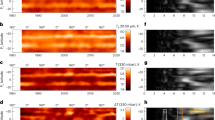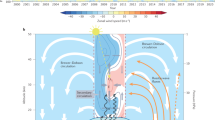Abstract
The equatorial stratospheres of Earth, Jupiter and Saturn all exhibit a remarkable periodic oscillation of their temperatures and winds with height. Earth’s quasi-biennial oscillation and Saturn’s quasi-periodic equatorial oscillation have recently been observed to experience disruptions in their vertical structure as a consequence of atmospheric events occurring far from the equator. Here we reveal that Jupiter’s quasi-quadrennial oscillation can also be perturbed by strong tropospheric activity at equatorial and off-equatorial latitudes. Observations of Jupiter’s stratospheric temperatures between 1980 and 2011 show two significantly different periods for the quasi-quadrennial oscillation, with a 5.7-yr period between 1980 and 1990 and a 3.9-yr period between 1996 and 2006. Major disruptions to the predicted quasi-quadrennial oscillation pattern in 1992 and 2007 coincided with marked planetary-scale disturbances in the equatorial and low-latitude troposphere, suggesting that they are connected to vertically propagating waves generated by meteorological sources in the deeper troposphere (that is 500–4,000-mbar pressures). Disruptions in Jupiter’s periodic oscillations are thus inherently different from those of Saturn or the Earth. This interconnectivity between the troposphere and stratosphere, which is probably common to all planetary atmospheres, shows that seemingly regular cycles of variability can switch between different modes when subjected to extreme meteorological events.
This is a preview of subscription content, access via your institution
Access options
Access Nature and 54 other Nature Portfolio journals
Get Nature+, our best-value online-access subscription
$29.99 / 30 days
cancel any time
Subscribe to this journal
Receive 12 digital issues and online access to articles
$119.00 per year
only $9.92 per issue
Buy this article
- Purchase on Springer Link
- Instant access to full article PDF
Prices may be subject to local taxes which are calculated during checkout




Similar content being viewed by others
Data availability
This work relies on ground-based data acquired at the IRTF. Jupiter images at 7.6–7.9 μm are available from A.A. and from L.N.F., and are in the process of being archived with NASA’s Planetary Data System. The cylindrical maps and the emission angle files used in this study to compute the zonal-mean brightness temperatures can be found at https://doi.org/10.5281/zenodo.3764712.
Change history
07 April 2021
A Correction to this paper has been published: https://doi.org/10.1038/s41550-021-01362-8
References
Leovy, C. B., Friedson, A. J. & Orton, G. S. The quasiquadrennial oscillation of Jupiter’s equatorial stratosphere. Nature 354, 380–382 (1991).
Baldwin, M. P. et al. The quasi-biennial oscillation. Rev. Geophys. 39, 179–230 (2001).
Fouchet, T. et al. An equatorial oscillation in Saturn’s middle atmosphere. Nature 453, 200–202 (2008).
Lindzen, R. S. & Holton, J. R. A theory of the quasi-biennial oscillation. J. Atmos. Sci. 25, 1095–1107 (1968).
Newman, P. A., Coy, L., Pawson, S. & Lait, L. R. The anomalous change in the QBO in 2015-2016. Geophys. Res. Lett. 43, 8791–8797 (2016).
Osprey, S. M. et al. An unexpected disruption of the atmospheric quasi-biennial oscillation. Science 353, 1424–1427 (2017).
Barton, C. & McCormack, J. Origin of the 2016 QBO disruption and its relationship to extreme El Niño events. Geophys. Res. Lett. 44, 11150–11157 (2017).
Orton, G. S. et al. Semi-annual oscillations in Saturn’s low-latitude stratospheric temperatures. Nature 453, 196–199 (2008).
Fletcher, L. N. et al. Disruption of Saturn’s quasiperiodic equatorial oscillation by the great northern storm. Nat. Astron. 1, 765–770 (2017).
Sánchez-Lavega, A. et al. Deep winds beneath Saturn’s upper clouds from a seasonal long-lived planetary-scale storm. Nature 475, 71–74 (2011).
Fischer, G. et al. A giant thunderstorm on Saturn. Nature 475, 75–77 (2011).
Fletcher, L. N. et al. Thermal structure and dynamics of Saturn’s northern springtime disturbance. Science 332, 1413–1417 (2011).
Fletcher, L. N. et al. The origin and evolution of Saturn’s 2011-2012 stratospheric vortex. Icarus 221, 560–586 (2012).
Orton, G. S. et al. Thermal maps of Jupiter—spatial organization and time dependence of stratospheric temperatures, 1980 to 1990. Science 252, 537–542 (1991).
Orton, G. S. et al. Spatial organization and time dependence of Jupiter’s tropospheric temperatures, 1980-1993. Science 265, 625–631 (1994).
Friedson, A. J. New observations and modelling of a QBO-like oscillation in Jupiter’s stratosphere. Icarus 137, 34–55 (1999).
Simon-Miller, A. A. et al. Jupiter’s atmospheric temperatures: from Voyager IRIS to Cassini CIRS. Icarus 180, 98–112 (2006).
Fletcher, L. N. et al. Moist convection and the 2010-2011 revival of Jupiter’s South Equatorial Belt. Icarus 286, 94–117 (2017).
Cosentino, R. G. et al. New observations and modeling of Jupiter’s quasi-quadrennial oscillation. J. Geophys. Res. 122, 2719–2744 (2017).
Fletcher, L. N. et al. Mid-infrared mapping of Jupiter’s temperatures, aerosol opacity and chemical distributions with IRTF/TEXES. Icarus 278, 128–161 (2016).
Guerlet, S. et al. Equatorial oscillation and planetary wave activity in Saturn’s stratosphere through the Cassini epoch. J. Geophys. Res. 123, 246–261 (2018).
Garcia, R. R., Dunkerton, T. J., Lieberman, R. S. & Vincent, R. A. Climatology of the semiannual oscillation of the tropical middle atmosphere. J. Geophys. Res. 102, 26019–26032 (1997).
Flasar, F. M. et al. An intense stratospheric jet on Jupiter. Nature 427, 132–135 (2004).
Peek, B. M. The Planet Jupiter (Faber and Faber, 1958).
Sanchez-Lavega, A., Miyazaki, I., Parker, D., Laques, P. & Lecacheux, J. A disturbance in Jupiter’s high-speed North temperate jet during 1990. Icarus 94, 92–97 (1991).
Coy, L., Newman, P. A., Pawson, S. & Lait, L. R. Dynamics of the disrupted 2015/16 quasi-biennial oscillation. J. Clim. 30, 5661–5674 (2017).
Fletcher, L. et al. Jupiter’s North Equatorial Belt expansion and thermal wave activity ahead of Juno’s arrival. Geophys. Res. Lett. 44, 7140–7148 (2017).
Rogers, J. H.The Giant Planet Jupiter (Cambridge University Press, 1995).
Rogers, J. H. The climax of Jupiter’s global upheaval. J. Br. Astron. Assoc. 117, 226–230 (2007).
Rogers, J. Jupiter in 1989-90. J. Br. Astron. Assoc. 102, 135–150 (1992).
García-Melendo, E., Sánchez-Lavega, A. & Dowling, T. E. Jupiter’s 24° N highest speed jet: vertical structure deduced from nonlinear simulations of a large-amplitude natural disturbance. Icarus 176, 272–282 (2005).
Sánchez-Lavega, A. et al. Depth of a strong jovian jet from a planetary-scale disturbance driven by storms. Nature 451, 437 (2008).
Antuñano, A. et al. Jupiter’s atmospheric variability from long-term ground-based observations at 5 μm. Astron. J. 158, 130 (2019).
Antuñano, A. et al. Infrared characterization of Jupiter’s equatorial disturbance cycle. Geophys. Res. Lett. 45, 10–987 (2018).
Yanamandra-Fisher, P., Orton, G. & Friedson, J. Time dependence of Jupiter’s tropospheric temperatures and cloud properties: the 1989 SEB disturbance. Bull. Am. Astron. Soc. 24, 1039 (1992).
Kuehn, D. & Beebe, R. A study of the time variability of Jupiter’s atmospheric structure. Icarus 101, 282–292 (1993).
Satoh, T. & Kawabata, K. A change of upper cloud structure in Jupiter’s South Equatorial Belt during the 1989-1990 event. J. Geophys. Res. 99, 8425–8440 (1994).
Sánchez-Lavega, A. & Gomez, J. The South Equatorial Belt of Jupiter, I: Its life cycle. Icarus 121, 1–17 (1996).
Moreno, F., Molina, A. & Ortiz, J. The 1993 south equatorial belt revival and other features in the Jovian atmosphere: an observational perspective. Astron. Astrophys. 327, 1253–1261 (1997).
Rogers, J. H. Jupiter embarks on a ‘global upheaval’. J. Br. Astron. Assoc. 117, 113–115 (2007).
Reuter, D. C. et al. Jupiter cloud composition, stratification, convection, and wave motion: a view from new horizons. Science 318, 223 (2007).
Fletcher, L. et al. Retrievals of atmospheric variables on the gas giants from ground-based mid-infrared imaging. Icarus 200, 154–175 (2009).
Torrence, C. & Compo, G. P. A practical guide to wavelet analysis. Bull. Am. Astron. Soc. 79, 61–78 (1998).
Scargle, J. D. Studies in astronomical time series analysis. II—Statistical aspects of spectral analysis of unevenly spaced data. Astron. J. 263, 835–853 (1982).
Chapa, S. R., Rao, V. B. & Prasad, G. S. S. D. Application of wavelet transform to Meteosat-derived cold cloud index data over South America. Mon. Weather Rev. 126, 2466–2481 (1998).
Huang, N. E. et al. The empirical mode decomposition and the Hilbert spectrum for nonlinear and non-stationary time series analysis. Proc. R. Soc. A 454, 903–995 (1998).
Acknowledgements
A.A. and L.N.F. are supported by a European Research Council Consolidator Grant under the European Union’s Horizon 2020 research and innovation programme, grant agreement number 723890, at the University of Leicester. L.N.F. is also supported by a Royal Society Research Fellowship. R.G.C.’s research was supported by an appointment to the NASA Postdoctoral Program at the NASA Goddard Space Flight Center, administered by Universities Space Research Association under contract with NASA. G.S.O. was supported by grants from NASA to the Jet Propulsion Laboratory, California Institute of Technology. A.A.S. was supported by grants from the Space Telescope Science Institute, which is operated by the Association of Universities for Research in Astronomy, Inc., under NASA contract NAS 5-26555. T.G. was funded in part by a NASA SSO subgrant through the Jet Propulsion Laboratory as well as by NASA PAST grant NNX14AG34G.
Author information
Authors and Affiliations
Contributions
A.A. was responsible for reducing and calibrating all the data, performing the wavelet-transform analysis and writing the article. R.G.C. performed the nonlinear Levenberg–Marquardt analysis and the temperature gradient analysis, and helped write the article. G.S.O., A.A.S., T.G. and L.N.F. were responsible for or assisted with the ground-based observations and helped with the discussion. All authors read and commented on the manuscript.
Corresponding author
Ethics declarations
Competing interests
The authors declare no competing interests.
Additional information
Publisher’s note Springer Nature remains neutral with regard to jurisdictional claims in published maps and institutional affiliations.
Extended data
Extended Data Fig. 1 Nonlinear Levenberg-Marquardt Fits.
Off-equatorial temperatures at ± 13∘ latitude as a function of time (a) showing a quasiperiodic pattern in relatively warmer and cooler temperatures. Best fits for the same years analyzed for the equatorial Models 1-4 in Fig. 3, but for 13∘ N (b) and 13∘ S (c). Models 1 and 4 for the equatorial and off-equatorial latitudes (d), showing the equatorial and off-equatorial anti-correlation.
Extended Data Fig. 2 Jupiter Meridional Temperature Gradients.
Meridional temperature gradients (in K/∘) as a function of time and latitude. Red indicates positive meridional gradients, while blue indicates the contrary. A drastic change in temperature gradients that clearly lined up with the two different QQO periods (that is 1992 and 2007) could provide a change in boundary conditions where additional wave energy might be transported from higher latitudes towards the equator. Note that no clear long term or seasonal dependence is observed.
Rights and permissions
About this article
Cite this article
Antuñano, A., Cosentino, R.G., Fletcher, L.N. et al. Fluctuations in Jupiter’s equatorial stratospheric oscillation. Nat Astron 5, 71–77 (2021). https://doi.org/10.1038/s41550-020-1165-5
Received:
Accepted:
Published:
Issue Date:
DOI: https://doi.org/10.1038/s41550-020-1165-5
This article is cited by
-
Moons and Jupiter Imaging Spectrometer (MAJIS) on Jupiter Icy Moons Explorer (JUICE)
Space Science Reviews (2024)
-
Dynamics and clouds in planetary atmospheres from telescopic observations
The Astronomy and Astrophysics Review (2023)
-
An intense narrow equatorial jet in Jupiter’s lower stratosphere observed by JWST
Nature Astronomy (2023)
-
Planetary Radio Interferometry and Doppler Experiment (PRIDE) of the JUICE Mission
Space Science Reviews (2023)
-
Jupiter Science Enabled by ESA’s Jupiter Icy Moons Explorer
Space Science Reviews (2023)



